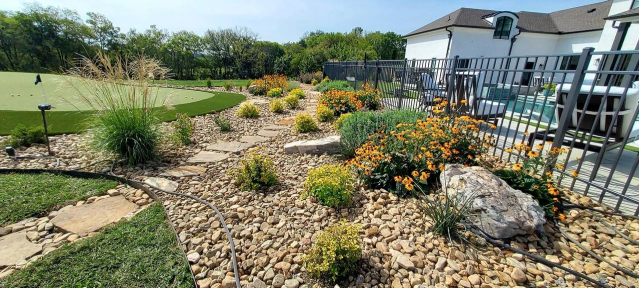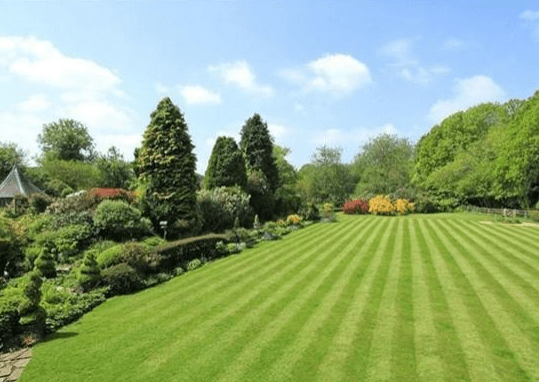Low Maintenance Landscapes
By Rhianne Doyle- Landscape Designer
Clients often inquire about Low Maintenance Landscapes when discussing residential landscapes and gardens. While it’s essential to note that all landscapes require some level of maintenance, achieving low-maintenance spaces is indeed possible. In these scenarios, I often turn to Xeric gardening, a style traditionally associated with arid climates. Derived from the Greek word “xeros,” meaning dry, this approach focuses on creating landscapes that thrive in arid conditions, showcasing the diverse beauty of drought tolerant plants while minimizing the need for water resources.
The recent significant temperature shifts in the Middle Tennessee region have prompted horticulturists to develop plant materials resilient to both heat and cold. This includes the integration of water-wise materials that can withstand increased sun exposure and thrive with reduced water. While it’s always important to choose the right plant for the right place, the emergence of hybrid cultivars aligns seamlessly with my goal of specifying plant materials for clients seeking low-maintenance or xeric-styled gardens.
These robust and sustainable plant introductions empower me to design landscapes ranging from minimalistic modern to lush gardens. This flexibility caters to clients who desire aesthetically pleasing outdoor spaces but lack the time to be constant gardeners.
If you’re considering enhancing your landscape or garden for the summer and are unsure where to begin, reach out for a consultation. Designing your landscape tailored to your preferences is the optimal way to achieve your gardening goals, leveraging not only the expertise of your designer but also the collective knowledge and resources of the entire Milosi Team.

Importance of Pre-emergent in Your Turf Applications Before Ground Temperatures Rise in Tennessee
By Keenan Baird- PHC & Fine Gardening Manager
Pre-emergent herbicides are a crucial component of effective turf management, as they work by blocking weed seeds from germinating before they have a chance to emerge in your lawn. These herbicides are granular chemicals that target weed seeds, preventing them from getting the opportunity to germinate and establish themselves in the turf. The mechanism behind pre emergent herbicides involves inhibiting plant root growth, seed cell division, and specific enzymes essential to the growth of certain plants. By understanding how preemergent herbicides work, you can better appreciate their importance in maintaining a healthy, weed-free lawn.
There are several benefits to using pre-emergent herbicides in turf applications, making them a vital part of promoting a healthy, green lawn. One of the primary advantages is that pre-emergent weed control is designed to prevent a variety of weeds before they appear. This is achieved by applying a protective layer of pre-emergent herbicide to the soil surface, preventing weed seeds from germinating and establishing themselves in the turf. In addition to preventing weed growth, applying pre-emergent herbicides can also: Save time and effort spent on post-emergent weed control measures – Reduce the need for chemical applications later in the season – Help maintain a consistent, aesthetically pleasing appearance for your lawn, and contribute to an overall turf health by reducing competition for nutrients, water, and sunlight. When incorporating pre-emergent herbicides into your turf management strategy, you can enjoy these benefits and foster a healthier, more attractive lawn.
There are several benefits to using pre-emergent herbicides in turf applications, making them a vital part of promoting a healthy, green lawn. One of the primary advantages is that pre-emergent weed control is designed to prevent a variety of weeds before they appear. This is achieved by applying a protective layer of pre-emergent herbicide to the soil surface, preventing weed seeds from germinating and establishing themselves in the turf. In addition to preventing weed growth, applying pre-emergent herbicides can also: Save time and effort spent on post-emergent weed control measures – Reduce the need for chemical applications later in the season – Help maintain a consistent, aesthetically pleasing appearance for your lawn, and contribute to an overall turf health by reducing competition for nutrients, water, and sunlight. When incorporating pre-emergent herbicides into your turf management strategy, you can enjoy these benefits and foster a healthier, more attractive lawn.
Q and A
Q: What is pre-emergent and how does it function in turf applications? A: Pre-emergent is a type of herbicide used to control and prevent the growth of weeds in turf. It functions by creating a chemical barrier in the soil that prevents weed seeds from germinating. When applied correctly, pre-emergent inhibits the process of cell division in weed seeds, effectively stopping them from developing into mature plants.
Q: Why is it important to apply pre-emergent before ground temperatures rise in Tennessee? A: Applying preemergent before the ground temperatures rise is crucial in weed prevention. In Tennessee, where the climate can favor weed growth, pre-emergent should be applied when soil temperatures reach about 55 degrees for several consecutive days, usually in late winter. This timing ensures the herbicide is in place before weed seeds begin to germinate with the rise in ground temperature.
Q: What are the benefits of using pre-emergent in turf applications? A: The use of pre-emergent in turf applications provides several benefits. First, it effectively controls the growth of weeds by preventing their seeds from germinating. This results in a healthier, more aesthetically pleasing turf. Second, it reduces the need for post-emergent applications, which can be more labor-intensive and costly. Lastly, it helps maintain the integrity of the turf by reducing competition for nutrients and water between the turf and the weeds.
Q: What are the best practices for applying pre-emergent in Tennessee? A: To maximize the effectiveness of preemergent, it should be applied twice a year: once in late winter when soil temperatures are about 55 degrees for several days, and again in fall when temperatures decrease to about 70 degrees.
Q: Can pre-emergent be applied in non-irrigated areas? A: Yes, pre-emergent can be applied in non-irrigated areas. However, it is important to remember that pre-emergent must be watered in to be effective. For nonirrigated areas or areas with a drip zone, it’s best to apply the pre-emergent just before rain is anticipated to ensure it gets properly watered in.
In conclusion, pre-emergent is a crucial component of any turf application, especially before ground temperatures rise in Tennessee. It works by preventing the germination of weed seeds, thereby reducing the need for postemergent herbicides. The benefits of using pre-emergent include a healthier and more attractive lawn, reduced maintenance costs, and increased property value. To ensure the best results, it is important to follow best practices for applying pre-emergent, such as timing the application correctly and using the appropriate amount. By incorporating pre-emergent into your turf management plan, you can enjoy a beautiful and weed-free lawn all season long. Are you interested in turf treatments? Call us today to set up a consultation!
